Oppo BDP-103 User Manual [nl]
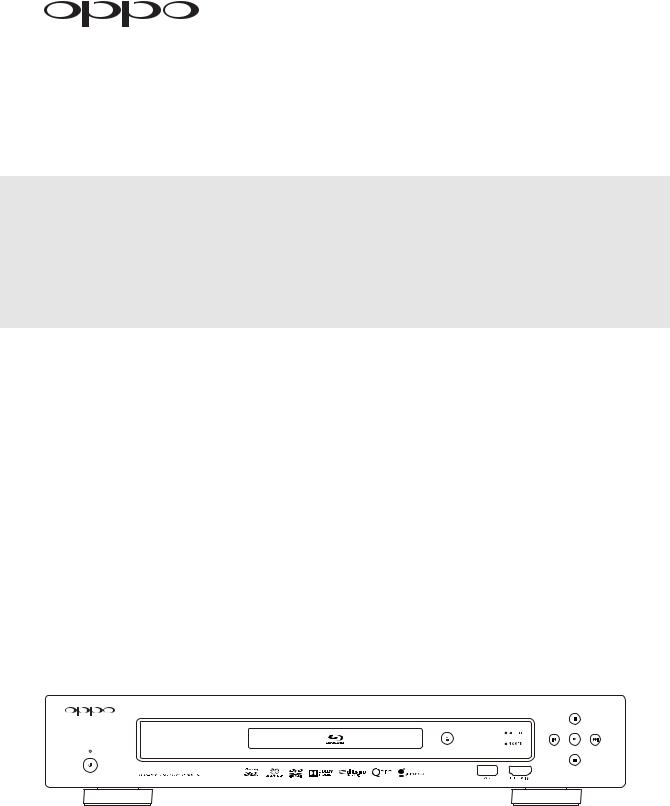
®
USER MANUAL
READ CAREFULLY BEFORE OPERATION
Blu-ray Disc Player BDP-103

Table of Contents |
|
IMPORTANT INFORMATION....................................................... |
1 |
Important Safety Instructions .................................................................................... |
1 |
Precautions ................................................................................................................. |
2 |
FCC Statement ............................................................................................................ |
2 |
Trademarks ................................................................................................................. |
3 |
Compatible Disc Types ............................................................................................... |
3 |
Discs that cannot be played............................................................................................................. |
4 |
Notes about BD-ROM compatibility ................................................................................................. |
4 |
Disc care and handling .................................................................................................................... |
4 |
Copyright Protection................................................................................................... |
4 |
Cinavia Notice............................................................................................................. |
4 |
Gracenote Notice ........................................................................................................ |
5 |
Region management information ............................................................................... |
5 |
Accessories................................................................................................................. |
5 |
INSTALLATION........................................................................... |
6 |
Front Panel Controls ................................................................................................... |
6 |
Front Panel Display Windows ..................................................................................... |
6 |
Rear Panel Connectors ............................................................................................... |
7 |
Remote Control ........................................................................................................... |
8 |
Remote Control Buttons................................................................................................................... |
8 |
Back Side......................................................................................................................................... |
9 |
Battery Installation ........................................................................................................................... |
9 |
Using the Remote Control................................................................................................................ |
9 |
Changing the Remote Code........................................................................................................... |
10 |
Changing the Backlight Method..................................................................................................... |
10 |
Common Connection Methods.................................................................................. |
11 |
Connecting to an A/V Receiver via HDMI...................................................................................... |
11 |
Connecting to a TV and A/V Receiver via Dual HDMI................................................................... |
12 |
Connecting to a TV via HDMI ........................................................................................................ |
13 |
Connecting to Two TVs via HDMI.................................................................................................. |
14 |
Connecting to a TV via DVI............................................................................................................ |
15 |
Alternate Audio Connections.................................................................................... |
16 |
Connecting to an A/V Receiver or Amplifier via Analog Outputs ................................................... |
16 |
Connecting to an A/V Receiver or Amplifier via S/PDIF (Coaxial / Optical)................................... |
17 |
HDMI / MHL INPUT to BDP-103 ................................................................................. |
18 |
Connecting to the Internet ....................................................................................... |
19 |
Internet connection through Ethernet cable................................................................................... |
19 |
i

Internet connection through wireless adaptor |
................................................................................20 |
Custom Installation ................................................................................................... |
21 |
External IR (Infrared Remote) Installation...................................................................................... |
21 |
RS232 Control................................................................................................................................ |
21 |
Quick Start Guide ...................................................................................................... |
22 |
Power On and Play ........................................................................................................................ |
22 |
Select the Best Output Resolution ................................................................................................. |
22 |
Determine the Display Aspect Ratio .............................................................................................. |
23 |
BASIC OPERATIONS ................................................................ |
24 |
Disc Playback ............................................................................................................ |
24 |
OPTION Menu............................................................................................................. |
24 |
Fast Playback ............................................................................................................ |
25 |
Pause and Frame-by-Frame....................................................................................... |
25 |
Slow Playback............................................................................................................ |
26 |
Blu-ray Disc Menu Playback...................................................................................... |
26 |
DVD Menu Playback................................................................................................... |
26 |
On-Screen Display...................................................................................................... |
27 |
Volume Control .......................................................................................................... |
27 |
Mute............................................................................................................................ |
28 |
Audio Language/Track Selection .............................................................................. |
28 |
Subtitle Selection ...................................................................................................... |
28 |
HDMI / MHL INPUT Selection .................................................................................... |
29 |
Audio Return Channel (ARC) Selection..................................................................... |
29 |
BD-Live ....................................................................................................................... |
30 |
ADVANCED OPERATIONS ........................................................ |
31 |
Output Resolution...................................................................................................... |
31 |
Zooming and Aspect Ratio Control ........................................................................... |
32 |
Zoom Levels for HDMI Output ....................................................................................................... |
32 |
Subtitle Shift .............................................................................................................. |
34 |
Repeat Playback........................................................................................................ |
34 |
Repeat a Selected Section........................................................................................ |
35 |
Shuffle and Random Playback .................................................................................. |
35 |
Playback by Chapter or Track Number..................................................................... |
35 |
Playback from a Specific Location ........................................................................... |
36 |
DVD and Blu-ray Discs .................................................................................................................. |
36 |
CD and SACD discs....................................................................................................................... |
37 |
Memory and Automatic Resume ............................................................................... |
38 |
Viewing Pictures on DVD-Audio Discs ...................................................................... |
38 |
Pure Audio Mode........................................................................................................ |
38 |
ii

MEDIA FILE PLAYBACK ........................................................... |
40 |
Playback from USB Flash Drive................................................................................ |
40 |
In-home Network Media Sharing .............................................................................. |
41 |
Internet Streaming on HOME Menu.......................................................................... |
42 |
Playing Music Files ................................................................................................... |
43 |
Playing Movie Files ................................................................................................... |
45 |
Viewing Photo Files .................................................................................................. |
46 |
Adding Background Music ........................................................................................ |
47 |
SETUP MENU OPTIONS .......................................................... |
48 |
Using the Setup Menu System.................................................................................. |
48 |
Playback Setup ......................................................................................................... |
51 |
Video Setup ............................................................................................................... |
53 |
Picture Adjustment......................................................................................................................... |
56 |
HDMI Options ................................................................................................................................ |
59 |
Audio Format Setup .................................................................................................. |
61 |
Audio Signal Reference Chart ....................................................................................................... |
64 |
Recommended Audio Format Options .......................................................................................... |
65 |
Audio Processing Setup............................................................................................ |
67 |
Speaker Configuration ................................................................................................................... |
67 |
Other Audio Processing Settings................................................................................................... |
71 |
Device Setup ............................................................................................................. |
72 |
Network Setup .......................................................................................................... |
76 |
REFERENCES........................................................................... |
80 |
Useful Notes.............................................................................................................. |
80 |
Troubleshooting ........................................................................................................ |
80 |
Specifications ........................................................................................................... |
82 |
User Manual Updates Online .................................................................................... |
82 |
Language Code List .................................................................................................. |
83 |
Gracenote Terms of Use ............................................................................................ |
84 |
LIMITED WARRANTY................................................................ |
85 |
OPPO Digital, Inc. Limited Two Years Warranty...................................................... |
85 |
iii

IMPORTANT INFORMATION
CAUTION
RISK OF ELECTRIC SHOCK.
DO NOT OPEN.
CAUTION: TO REDUCE THE RISK OF ELECTRIC SHOCK, DO NOT REMOVE COVER (OR BACK). NO USER-SERVICEABLE PARTS INSIDE. REFER SERVICING TO QUALIFIED SERVICE PERSONNEL.
The lightning flash with arrowhead symbol, within an equilateral triangle, is intended to alert the user to the presence of uninsulated “dangerous voltage”
within the product's enclosure that may be of sufficient magnitude to constitute a risk of electric shock to persons.
The exclamation point within an equilateral triangle is intended to alert the user to the presence of important operation and maintenance (servicing)
instruction in the literature accompanying the appliance.
WARNING:
TO REDUCE THE RISK OF FIRE OR ELECTRIC SHOCK, DO NOT EXPOSE THIS APPLIANCE TO RAIN OR MOISTURE. DANGEROUS HIGH VOLTAGES ARE PRESENT INSIDE THE ENCLOSURE. DO NOT OPEN THE CABINET. REFER SERVICING TO QUALIFIED PERSONNEL ONLY.
THE APPARATUS SHALL NOT BE EXPOSED TO DRIPPING OR SPLASHING AND THAT NO OBJECTS FILLED WITH LIQUIDS, SUCH AS VASES SHALL BE PLACED ON THE APPARATUS.
CAUTION:
DANGER OF EXPLOSION IF BATTERY IS INCORRECTLY REPLACED. REPLACE ONLY WITH THE SAME OR EQUIVALENT TYPE.
THIS PRODUCT UTILIZES A LASER. USE OF CONTROLS OR ADJUSTMENTS OR PERFORMANCE OF PROCEDURES OTHER THAN THOSE SPECIFIED HEREIN MAY RESULT IN HAZARDOUS RADIATION EXPOSURE. DO NOT OPEN COVERS AND DO NOT REPAIR YOURSELF. REFER SERVICING TO QUALIFIED PERSONNEL.
This label is located on the laser protective housing inside the product.
Important Safety Instructions
1)Read these instructions.
2)Keep these instructions.
3)Heed all warnings.
4)Follow all instructions.
5)Do not use this apparatus near water.
6)Clean only with dry cloth.
7)Do not block any ventilation openings. Install in accordance with the manufacturer’s instructions.
8)Do not install near any heat sources such as radiators, heat registers, stoves, or other apparatus (including amplifiers) that produce heat.
9)Do not defeat the safety purpose of the polarized or grounding-type plug. A polarized plug has two blades with one wider than the other. A grounding type plug has two blades and a third grounding prong. The wide blade or the third prong is provided for your safety. If the provided plug does not fit into your outlet, consult an electrician for replacement of the obsolete outlet.
10)Protect the power cord from being walked on or pinched, particularly at plug, receptacle, and the point where it exits from the apparatus.
11)Only use attachments/accessories specified by the manufacturer.
12)Use only with the cart, stand, tripod,
bracket, or table specified by the manufacturer, or sold with the apparatus. When a cart is used, use caution when moving the cart/apparatus combination to avoid injury from tip-over.
13)Unplug this apparatus during lightning storms or when unused for long periods of time.
14)Refer all servicing to qualified service personnel. Servicing is required when the apparatus has been damaged in any way, such as power-supply cord or plug is damaged, liquid has been spilled or objects have fallen into the apparatus, the apparatus has been exposed to rain or moisture, does not operate normally, or has been dropped.
15)Batteries (battery pack or batteries installed) shall not be exposed to excessive heat such as sunshine, fire or the like.
1

I M P O R T A N T I N F O R M A T I O N
Precautions
xBefore connecting the AC power cord to the appliance, make sure the voltage designation of the appliance corresponds to the local electrical supply. If you are unsure of your power supply, contact your local power company. The acceptable power input range is AC ~ 100V-240V, 50/60Hz.
xThe apparatus with CLASS I construction shall be connected to a MAINS socket outlet with a protective earthing connection.
xThe player is still receiving power from the AC power source as long as it is connected to the wall outlet, even if the player itself has been turned off.
xUnplug the power cord if you are not going to use the product for an extended period of time. Hold the power plug when unplugging. Do not pull on the cord.
xThe main plug is used as the mechanism for cutting off power, therefore make sure it is easy to unplug.
FCC Statement
This equipment has been tested and found to comply with the limits for a Class B digital device, pursuant to Part 15 of the FCC Rules. These limits are designed to provide reasonable protection against harmful interference in a residential installation. This equipment generates, uses, and can radiate radio frequency energy and, if not installed and used in accordance with the instructions, may cause harmful interference to radio communications. However, there is no guarantee that interference will not occur in a particular installation. If this equipment does cause harmful interference to radio or television reception, which can be determined by turning the equipment off and on, the user is encouraged to try to correct the interference by one or more of the following measures:
xReorient or relocate the receiving antenna.
xTo ensure proper ventilation around this product, do not place this product on a sofa, bed or rug. When installing this product on a wall or bookshelf, you need to provide appropriate space: we recommend leaving 4 inches (10 cm) of free space at the top, the sides and the rear.
xHigh temperature will lead to abnormal operation of this unit. Do not expose this unit or batteries to direct sunlight or near other heating objects.
xWhen moving the player from a cold location to a warm one, or vice versa, moisture may condense on the laser pickup unit inside the player. Should this occur, the player may not operate properly. In such a case please turn the unit on for 1-2 hours (without a disc) to facilitate moisture evaporation.
xIncrease the separation between the equipment and receiver.
xConnect the equipment into an outlet on a circuit different from that to which the receiver is connected.
xConsult the dealer or an experienced radio/TV technician for help.
Any unauthorized changes or modifications to this equipment would void the user’s authority to operate this device.
This device complies with Part 15 of the FCC Rules. Operation is subject to the following two conditions: (1) This device may not cause harmful interference, and (2) this device must accept any interference received, including interference that may cause undesired operation.
2
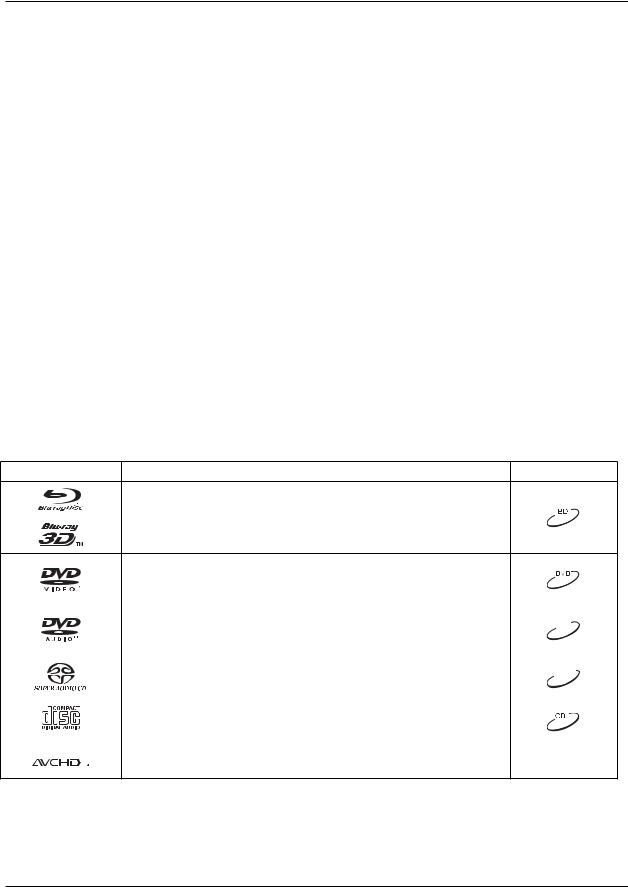
I M P O R T A N T I N F O R M A T I O N
Trademarks
x“Blu-ray Disc”, “Blu-ray 3D”, “BONUSVIEW” and “BDLive” are trademarks of Blu-ray Disc Association.
xJava and all Java-based trademarks and logos are trademarks or registered trademarks of Sun Microsystems, Inc. in the United States and other countries.
xDVD Logo is a trademark of DVD Format/Logo Licensing Corp., registered in the U.S., Japan and other countries.
xSuper Audio CD, SACD and the SACD logo are joint trademarks of Sony Corporation and Philips Electronics N.V. Direct Stream Digital (DSD) is a trademark of Sony Corporation.
x“AVCHD” and the “AVCHD” logo are trademarks of Panasonic Corporation and Sony Corporation.
xDesigned for Windows Media, Microsoft, HDCD, and the HDCD logo are trademarks or registered trademarks of Microsoft Corporation in the United States and/or other countries.
x“480i/480p/720p/1080i/1080p” up-converting arrow logo, “Source Direct” and “True 24p” logos are trademarks of OPPO Digital, Inc.
x“Netflix” is a registered trademark of Netflix, Inc.
x“Qdeo” is trademark of Marvell or its affiliates.
xManufactured under license under U.S. Patent Nos: 5,956,674; 5,974,380; 6,226,616; 6,487,535; 7,212,872; 7,333,929; 7,392,195; 7,272,567 & other U.S. and worldwide patents issued & pending. DTSHD, the Symbol, & DTS-HD and the Symbol together are registered trademarks & DTS-HD Master Audio is a trademark of DTS, Inc. Product includes software. © DTS, Inc. All Rights Reserved.
xManufactured under license from Dolby Laboratories. Dolby and the double-D symbol are trademarks of Dolby Laboratories.
xHDMI, the HDMI logo and High-Definition Multimedia Interface are trademarks or registered trademarks of HDMI Licensing LLC.
x“Pandora” is trademark of Pandora, Inc.
x“Gracenote” is trademark of Gracenote, Inc.
x“Cinavia” is trademark of Verance Corporation.
xAll other trademarks are the properties of their respective owners.
Compatible Disc Types
Logo |
Features |
Manual Icon |
BD: Supports Blu-ray with Bonus View and BD-Live content, including Blu-ray 3D discs. A 3D-capable display with compatible glasses is required for 3D playback. BD-R/RE, both singleand dual-layer are also supported.
DVD: Plays commercially-released DVDs, as well as finalized DVD±R/RW. |
|
|
|
DVD-A: High-resolution stereo or multi-channel audio. Some DVD-Audio discs |
DVD-A |
also contain a DVD-Video portion. |
|
|
|
SACD: High-resolution stereo or multi-channel audio. Note: some SACDs use |
SACD |
a hybrid format with both a CD and a high resolution DSD layer. |
|
|
|
CD: Supports standard Red Book CDs, as well as HDCD and CD-R/RW. |
|
|
|
AVCHD: High-definition digital video camera format, often in the form of a |
|
DVD±R or flash memory. |
|
3
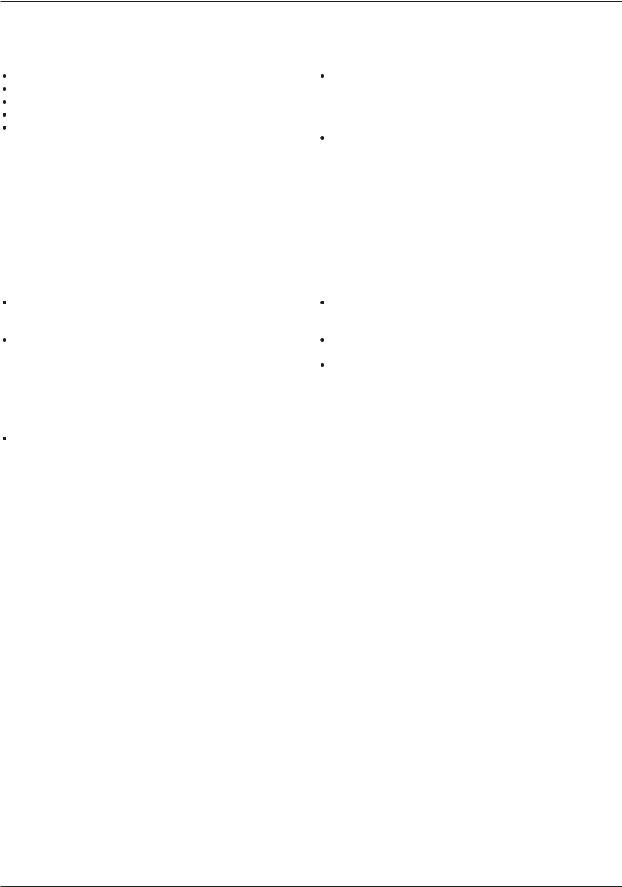
I M P O R T A N T I N F O R M A T I O N
Discs that cannot be played
BDs with cartridge DVD-RAMs HD-DVDs
Data portion of CD-Extras
DVDs / Blu-Rays with a region code other than 1 or A
Some Dual-Discs: A Dual-Disc is a two-sided disc with DVD-video on one side and digital audio on the other side. The digital audio side does not meet the technical specifications of the Red Book CD format so playback is not guaranteed.
Audio discs with copy-protection may not be playable.
Notes about BD-ROM compatibility
Since the Blu-ray Disc specifications are new and evolving, some discs may not play properly depending on the disc type, version and encoding. It is possible that a Blu-ray Disc manufactured after the player uses new features of the Blu-ray Disc specifications. To ensure the best possible viewing experience, the player may need a firmware or software update from time to time. Please visit OPPO Digital’s web site www.oppodigital.com to check if updates are available.
Disc care and handling
To keep the disc clean from scratches or fingerprints, handle the disc by its edge. Do not touch the recorded surface.
Blu-ray Discs record data in very high density and the recorded layer is very close to the disc surface. For this reason, Blu-ray Discs are more sensitive to dust and fingerprints than DVD. Should you encounter playback problems and see dirty spots on the disc surface, clean the disc with a cleaning cloth. Wipe the disc from the center out along the radial direction. Do not wipe the disc in a circular motion.
Do not use record cleaning sprays or solvents such as benzene, thinner and anti-static spray.
Do not attach labels or stickers to discs as this may cause the disc to warp or become too thick, resulting in playback issues and a potentially stuck disc.
Avoid exposing the discs to direct sunlight or heat sources.
Do not use the following discs:
oDiscs with exposed adhesive from removed stickers or labels. The disc may get stuck inside the player.
oWarped or cracked discs.
oIrregularly shaped discs, such as heart or business card shapes.
Copyright Protection
This product incorporates copyright protection technology that is protected by U.S. patents and other intellectual property rights of Rovi Corporation. The use of Rovi Corporation's copyright protection technology in the product must be authorized by Rovi Corporation. Reverse engineering and disassembly are prohibited.
Cinavia Notice
This product uses Cinavia technology to limit the use of unauthorized copies of some commercially-produced film and videos and their soundtracks. When a prohibited use of an unauthorized copy is detected, a message will be displayed and playback or copying will be interrupted.
More information about Cinavia technology is provided at the Cinavia Online Consumer Information Center at http://www.cinavia.com. To request additional information about Cinavia by mail, send a postcard with your mailing address to: Cinavia Consumer Information Center, P.O. Box 86851, San Diego, CA, 92138, USA.
4

I M P O R T A N T I N F O R M A T I O N
Gracenote Notice
Music and Video recognition technology and related data are provided by Gracenote®. Gracenote is the industry standard in music and video recognition technology and related content delivery. For more information visit www.gracenote.com.
CD, DVD, Blu-ray Disc, and music and video-related data from Gracenote, Inc., copyright © 2000 to present Gracenote. Gracenote Software, copyright © 2000 to present Gracenote. One or more patents owned by Gracenote may apply to this product and service. See the Gracenote website for a non-exhaustive list of applicable Gracenote patents. Gracenote, CDDB, MusicID, the Gracenote logo and logotype, and the "Powered by Gracenote" logo are either registered trademarks or trademarks of Gracenote in the United States and/or other countries.
Region management information
This player is designed and manufactured to respond to the region management information. If the region number of a BD-Video or DVD disc does not correspond to the region number of this player, this player cannot play the disc.
BD-Video: This player plays Blu-Ray Discs with marks containing the region code A.
DVD-Video: This player plays DVDs with marks containing the region code 1 and ALL.
Accessories
Please check that the following parts are included in your BDP-103 package:
User Manual |
|
|
|
HDMI 1.4 Cable, about 6 feet |
USB Wireless-N Adapter (up to 150Mbps, |
|
|
|
USB Extension Cable, about 4.5 feet |
802.11b/g/n compatible, 2.4GHz) |
|
|
|
|
Power Cable, about 4.5 feet |
|
|
|
Remote Control with AA Batteries |
|
|
|
5

INSTALLATION
Front Panel Controls
1 |
2 |
3 |
4 |
5 |
6 |
7 |
8 |
9 |
10 |
11 |
1. |
POWER Button |
4. |
Disc Tray |
7. |
USB 2.0 Input |
10. |
MHL-Compatible |
2. |
POWER Status |
5. |
OPEN/CLOSE Tray |
8. |
3D Output Active |
|
HDMI Input |
|
Indicator |
|
Button (with backlight) |
|
Indicator |
11. |
Playback Control |
3. |
Front Panel Display |
6. |
IR Sensor Window |
9. |
4K x 2K Output |
|
and Navigation |
Window |
Buttons |
|
Active Indicator |
||
|
Front Panel Display Windows |
|
|
|
|
|
|
|
|
|
|
|||
1 |
2 |
3 |
4 |
5 |
6 |
7 |
8 |
9 |
10 |
11 |
12 |
13 |
13 |
1.Mute Icon – Indicates that the audio is muted
2.Audio Type Indication – Indicates the type of audio tracks being played
3.Disc Type Indication – Indicates the currently playing disc type
4.Main Display – Text messages and numeric display
5.Title – When illuminated, the displayed time applies to a title
6.Group – When illuminated, the displayed time applies to a group
7.Chapter – When illuminated, the displayed time applies to a chapter
8.Track – When illuminated, the displayed time applies to a track
9.Audio Channel Indication – Indicates whether the audio being played is 2ch stereo or multi-channel surround
10.Remaining – When illuminated, the displayed time is the remaining play time
11.Playback Status – Indicates playback status such as Play, Pause, Repeat, Repeat All, and Random Mode
12.Ethernet – Indicates that an active Ethernet cable is attached
13.Wireless – Indicates that the player is connected to a wireless network
6

I N S T A L L A T I O N
Rear Panel Connectors
1 |
2 |
3 |
4 |
5 |
6 |
7 |
8 |
9 |
10 |
11 |
12 |
1. |
Ethernet LAN Port |
6. |
HDMI 2 Output (3D Compatible) |
11. |
RS-232C Serial Control Port |
2. |
HDMI Input (Back) |
7. |
HDMI 1 Output (3D Compatible) |
12. |
7.1CH / 5.1CH / Stereo Analog |
3. |
Diagnostic Video Output |
8. |
USB 2.0 Input |
|
Audio Outputs |
|
|
||||
4. |
Coaxial Digital Audio Output |
9. |
USB 2.0 Input |
|
|
5. |
Optical Digital Audio Output |
10. |
IR (Infrared) Signal Input |
|
|
In addition to the above connectors, the AC power inlet is also located on the rear panel. The inlet is the IEC60320 C14 type. Only the included AC power cord or an approved power cord with an IEC60-320 C14 type plug should be used.
7
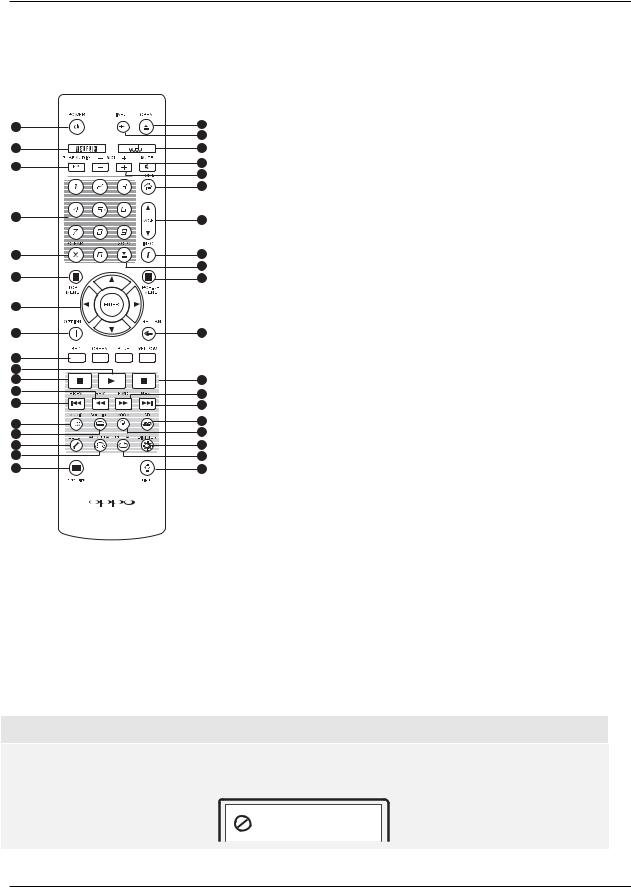
I N S T A L L A T I O N
Remote Control
Remote Control Buttons
1 |
19 |
|
20 |
||
|
2 |
21 |
|
3 |
22 |
|
23 |
||
|
||
|
24 |
|
4 |
25 |
|
|
||
5 |
26 |
|
|
27 |
|
6 |
28 |
|
7 |
|
|
8 |
29 |
|
9 |
|
|
10 |
|
|
11 |
30 |
|
12 |
31 |
|
|
||
13 |
32 |
|
14 |
33 |
|
34 |
||
15 |
||
|
||
16 |
35 |
|
17 |
36 |
|
18 |
37 |
1.POWER: Toggle power STANDBY and ON
2.NETFLIX: Netflix access button
3.PURE AUDIO: Turn off/on video
NOTE
4.NUMBER Buttons: Enter numeric values
5.CLEAR: Clear numeric input
6.TOP MENU: Show BD top menu or DVD title menu
7.ARROW and ENTER
Buttons: Navigate menu selection
8.OPTION: Brings up the context-related menu
9.COLOR Buttons: Function varies by content
10.PLAY: Start playback
11.STOP: Stop playback
12.REV: Fast reverse play
13.PREV: Skip to previous
14.AUDIO: Change audio language or channel
15.SUBTITLE: Change subtitle language
16.SETUP: Enter the player Setup Menu
17.A-B REPLAY: Repeat play the selected section
18.RESOLUTION: Switch output resolution
19.OPEN: Open/close the disc tray
20.INPUT: Select the input source
21.VUDU: VUDU access button
22.MUTE: Mute audio
23.VOLUME +/-: Increase/Decrease volume
24.HOME: Go to Home Menu to select media source
25.PAGE UP/DOWN: Show the previous/next page
26.INFO: Show/hide the On-Screen Display
27.GOTO: Play from a specified location
28.POP-UP MENU: Show BD pop-up menu or DVD menu
29.RETURN: Return to the previous menu or mode
30.PAUSE: Pause playback
31.FWD: Fast forward play
32.NEXT: Skip to the next
33.3D: Enable 2D->3D conversion or bring the 3D adjustment menu
34.ZOOM: Zoom in/out and adjust aspect ratio
35.DIMMER: Dim the front panel display
36.REPEAT: Repeat play
37.LIGHT: Activate the back light for the remote control
When a button is pressed but its function is invalid or unavailable at the moment, the TV screen displays a circle with a diagonal line:
8
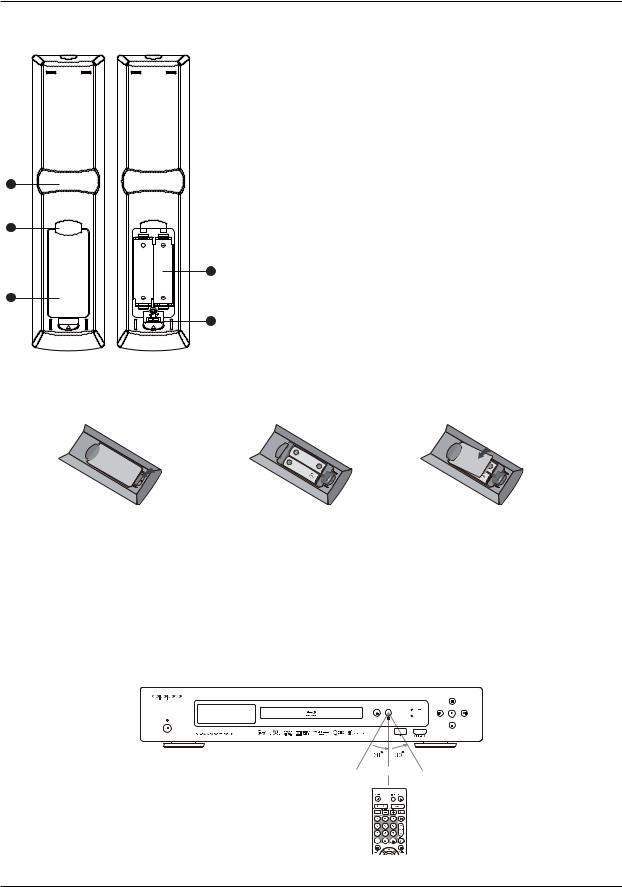
I N S T A L L A T I O N
Back Side
1
2
4
3
5
With Battery Cover |
Battery Cover Removed |
1.Index Finger Notch 1: When your index finger is placed at this notch while holding the remote control, your thumb is within easy reach of the navigation buttons (ARROW, ENTER, TOP MENU and POP-UP MENU).
2.Index Finger Notch 2: When your index finger is placed at this notch while holding the remote control, your thumb is within easy reach of the playback control buttons (STOP, PLAY, PAUSE, PREV, NEXT, REV, FWD).
3.Battery Cover: Remove to replace batteries or set remote code.
4.Batteries: Use 2 AA or LR6 batteries.
5.Remote Code Switch: Adjust the position of the switch to set the remote control to use the indicated remote code (see details on page 10).
Battery Installation
1. Remove the battery |
2. Insert batteries |
3. Replace the battery |
compartment cover |
|
compartment cover |
Using the Remote Control
When using the remote control, the front window of the remote control should be pointed to the infrared sensor on the front panel within an angle of ±30° and a range of about 26 ft.
Within about 26ft
9

I N S T A L L A T I O N
Changing the Remote Code
The remote control contains three OPPO remote codes. The default is “Code 1”. If you have other OPPO products placed close to the BDP-103, they may inadvertently respond to the BDP-103 remote control. To prevent this, you can select a different remote code.
To select a new remote code, open the battery compartment cover of the remote control, and then use a ball point pen to flip the switch to one of the positions marked as “1”, “2”, or “3”. Close the battery compartment cover. Make sure that the BDP-103 player is turned on and that the disc tray is ejected. Aim the remote control at the player. Press and hold the ENTER button for 5 seconds. The player will start using the new remote code.
Battery Compartment
Remote Code Switch
Changing the Backlight Method
The remote control supports one of two backlight methods. By default, pressing the LIGHT button will turn on the backlight, and pressing any other button within 10 seconds will keep the backlight on. The alternative method will activate the backlight whenever any button is pressed; in this mode, the light will stay on for 10 seconds, and pressing any other button will keep the backlight on. To switch between these two backlight methods, press and hold the LIGHT button for 5 seconds.
CAUTION
xNever drop the remote control or expose it to moisture.
xNever expose the infrared remote sensor on the front panel to direct sunlight or other strong light sources.
xRemote may not operate consistently when batteries become low. Replace them if operation deteriorates.
xIf the remote control will not be used for a long time, please remove the batteries.
xUse the batteries correctly to avoid possible leakage and corrosion. Do not leave the batteries exposed to direct sunlight or in a high temperature environment for a long period of time. Do not heat or expose to flame. Do not mix old and new batteries. Do not use batteries of different types at the same time. Do not attempt to recharge the batteries.
xIf battery leakage occurs, do not touch the liquid with bare hands. Wipe out any liquid inside the battery compartment, and insert new batteries.
10
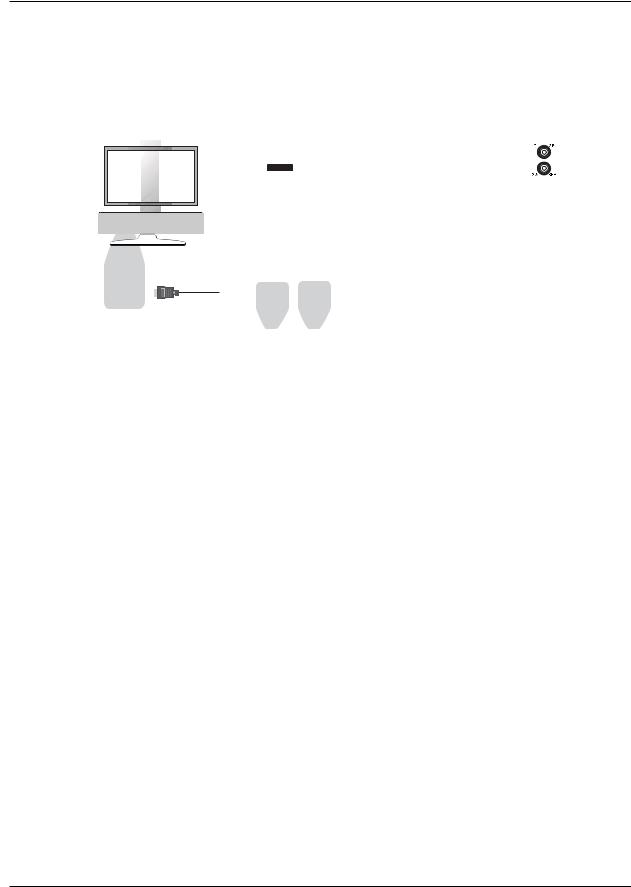
I N S T A L L A T I O N
Common Connection Methods
Connecting to an A/V Receiver via HDMI
Rear Panel
HDMI In |
HDMI Cable |
|
(to HDMI 1 or 2) |
||
HDMI Cable |
||
HDMI OUT |
HDMI IN |
xIf you have an HDMI-capable receiver that can support HDMI audio, you can simply run an HDMI cable from the player to your receiver and enable HDMI audio on the receiver (see your receiver’s owner’s manual for more information). The receiver usually has an HDMI output that you can connect to your TV to pass the video signal.
xEither of the HDMI output terminals (HDMI 1 OUT and/or HDMI 2 OUT) on the rear panel of the BDP-103 can be connected to your receiver. Preference should be given to the HDMI 1 output for video since it is the only output to benefit from the superior Marvell QDEO video processor.
NOTE
HDMI (High-Definition Multimedia Interface) is a single cable that can transport both audio and video from your player to your display. Be aware, however, that HDMI is an evolving standard, and there may be compatibility issues. A receiver that supports audio input over HDMI is required. Some receivers offer HDMI ports solely for video switching. If your receiver does not have audio input capability, please read the following sections regarding other connection methods.
In order to play multi-channel audio for all formats, the receiver must support HDMI v1.1 or later. For Blu-ray Discs, a receiver that supports HDMI v1.4 with decoding capability for Dolby TrueHD and DTS-HD Master Audio is preferred. Please check the specifications of your receiver to ensure that it meets these requirements.
The HDMI outputs on the BDP-103 are HDMI v1.4, which are compatible with HDMI v1.3 and earlier versions.
11
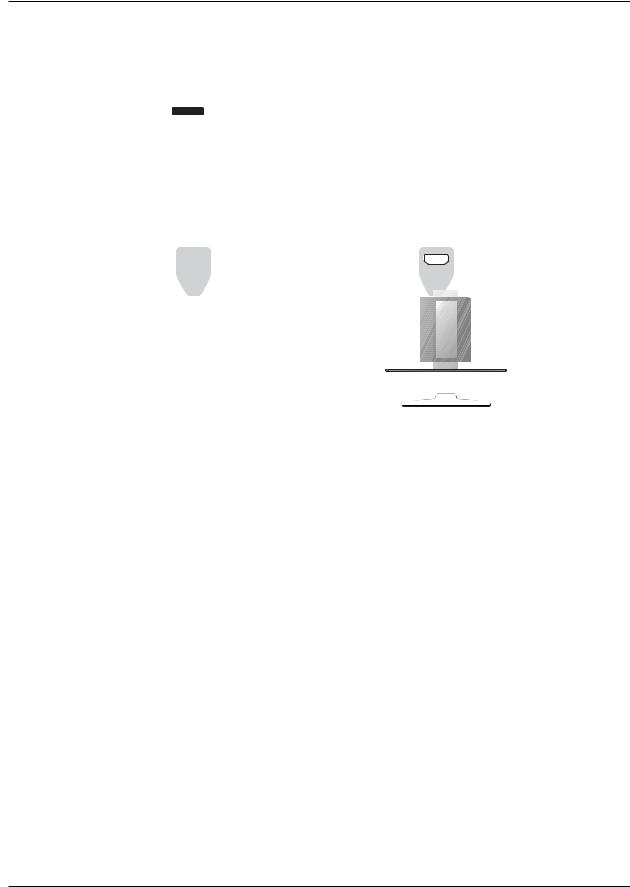
I N S T A L L A T I O N
Connecting to a TV and A/V Receiver via Dual HDMI
Rear Panel
|
|
|
|
|
|
|
|
|
|
|
|
|
|
|
|
|
|
|
|
|
|
|
|
|
|
|
|
|
|
|
|
|
|
|
|
|
|
|
|
|
|
|
|
|
|
|
|
|
|
|
|
|
|
|
|
|
|
|
|
|
|
|
|
|
|
|
|
|
|
HDMI Cable 2 |
HDMI Cable 1 |
|
|
|
|
|
|
|
|
|
|
|
|
|
|||
|
|
|
|
|
|
|
|
|||
|
|
|
|
|
|
|
|
|
|
|
|
|
|
|
|
|
|
|
|
|
|
|
HDMI IN |
|
|
|
|
HDMI IN |
||
|
|
|
AUDIO/VIDEO MULTI-CHANNEL RECEIVER |
|
|
|
||
|
|
|
|
|
|
|||
|
|
|
|
|
|
|||
|
|
|
|
|
|
|
|
|
|
|
|
|
|
|
|
|
|
|
|
|
|
|
|
|
|
|
|
|
|
|
|
|
|
|
|
|
|
|
|
|
|
|
|
|
|
|
|
|
|
|
|
|
|
|
|
|
|
|
|
|
|
|
|
|
|
|
|
|
|
|
|
|
|
|
|
|
|
|
|
|
|
|
|
|
|
|
|
|
|
|
|
|
|
|
|
|
|
|
|
|
|
|
|
|
|
|
|
xThe BDP-103 provides a “Dual HDMI” connection to make sure you can enjoy the highest possible video quality and resolution, in addition to high bit rate audio content. You can use the included HDMI cable to connect the HDMI 1 output to your HDTV and use another HDMI cable (not included) to connect the HDMI 2 output to your receiver by setting the Dual HDMI Output option in the Setup Menu to Split A/V (see page 53 for details). In this way you can utilize the dedicated video processor available for the HDMI 1 output, and allow your receiver which has no HDMI 1.4 inputs to work without any loss to the digital audio signals.
xThis configuration is recommended when you have a 3D-compatible display, but your receiver is not 3D-compatible. This allows you to send the video signal (3D, in this case) directly to the TV and the audio signal to the receiver to be distributed to your speakers as it normally would.
NOTE
xPlease refer to the notes on HDMI connections available on page 11.
xIf your receiver does not have HDMI audio input capability, please try the alternate connection methods discussed on pages 16 and 17.
12
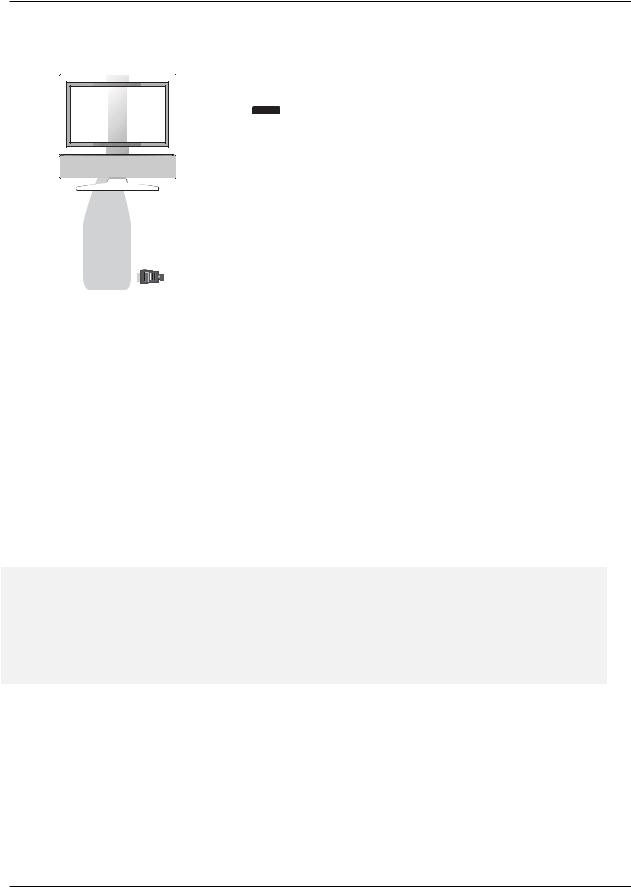
I N S T A L L A T I O N
Connecting to a TV via HDMI
Rear Panel
Video In
Composite Cable (Optional)
HDMI In
HDMI Cable (to HDMI 1 or 2)
xIf your TV has an HDMI input, you can use the included HDMI cable to connect the player directly to the TV. This connection method delivers both video and audio in a pure digital format via a single cable. The HDMI output of the player allows for the highest possible video quality and audio resolution.
xThere are two HDMI output terminals (HDMI 1 OUT and HDMI 2 OUT) on the rear panel of BDP103, both of which can be connected to your TV. We recommend using HDMI 1 OUT since it benefits from the dedicated Marvell QDEO video processor.
xYou may remove the HDMI cable and connect the DIAG (diagnostic) output to the TV through a regular composite video cable (not included) when there is a problem with HDMI video. Only the Setup Menu will be visible on the TV when using this connection, so it is limited to troubleshooting purposes only.
NOTE
xThis connection method will output sound via the TV’s speakers. For optimal sound quality, it is recommended that audio be transferred from the BDP-103 to an A/V receiver with connected speakers.
xIf your A/V receiver does not accept audio via HDMI, or if your receiver does not have HDMI inputs at all, see pages 16 and 17 for instructions on how to output audio to a receiver using different connection types.
13
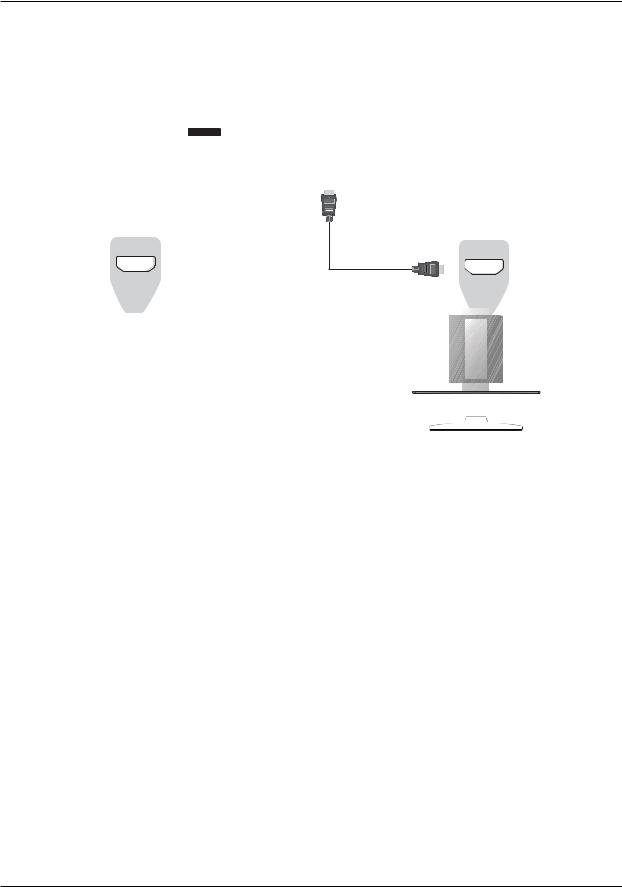
I N S T A L L A T I O N
Connecting to Two TVs via HDMI
Rear Panel
HDMI In |
HDMI In |
|
HDMI Cables
|
|
|
TV 2 |
|
|
|
|
|
|
|
|
|
|
|
|
|
|
|
|
|
|
|
|
|
|
|
|
|
|
|
|
|
|
|
|
|
|
|
|
|
|
|
TV 1 |
|
|
|
|
|
|
|
|
|
|
||
|
|
|
|
|
|
|
|
xThe two HDMI outputs (HDMI 1 OUT and HDMI 2 OUT) available on the rear panel of BDP-103 can be connected to two TVs at the same time, and each output can deliver both digital video and audio signals.
xWe recommend that you connect your main TV (the one with larger screen size or the one that you would watch more often) to HDMI 1 OUT in order to benefit from the dedicated video processor, and set the Dual HDMI option in the Setup Menu to Dual Display to make sure that the HDMI 2 OUT can also send out audio and video signals (see more details on page 53).
xYou may connect the DIAG (diagnostic) output to one of your TVs for troubleshooting purposes. Refer to page 13 for more details.
14
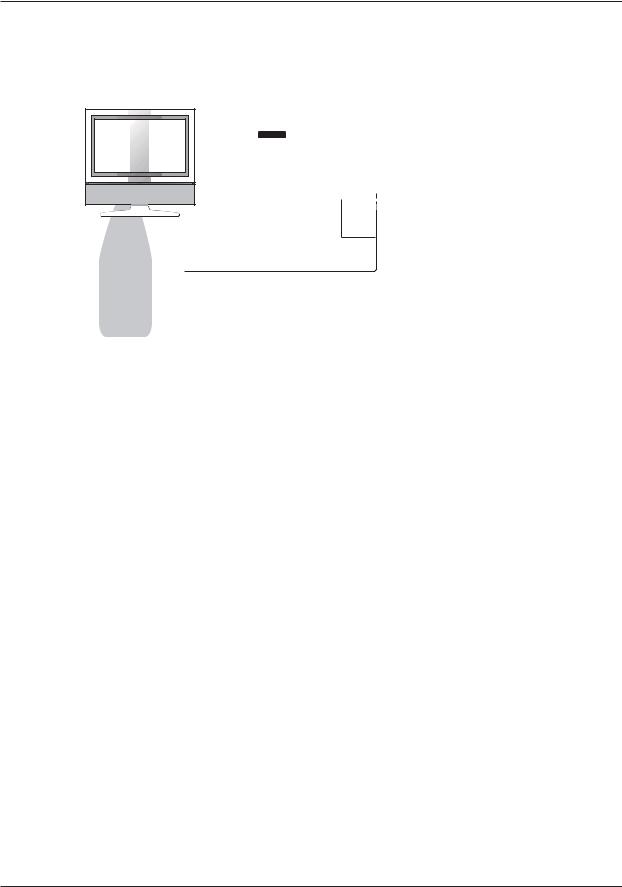
I N S T A L L A T I O N
Connecting to a TV via DVI
Rear Panel
DVI
HDMI (from HDMI 1 or 2) - DVI Cable
DVI Audio
Audio Cable
xIf your TV has a DVI input that supports HDCP, you can purchase an HDMI-DVI cable to connect the player to the TV. This connection method delivers digital video to the TV without any signal degradation. We recommend that you use HDMI 1 OUT since it benefits from the dedicated video processor.
xPlease use Red/White audio cables (not included) to connect the FL (Front Left) and FR (Front Right) terminals of the player to the TV. Make sure the audio cables are connected to the same input terminal group on the TV as the DVI input. Usually, the input terminals are marked as “DVI Audio” or “PC Audio”. On some TVs you may need to use an RCA-3.5mm Mini-Jack adapter cable to connect the audio.
xYou may connect the DIAG (diagnostic) output to one of your TVs for troubleshooting purpose. Refer to page 13 for more details.
NOTE
HDCP stands for High-bandwidth Digital Content Protection. The HDMI outputs of the BDP-103 use HDCP to encrypt the digital audio and video content. The TV must support HDCP in order to decrypt and properly display the content.
15

I N S T A L L A T I O N
Alternate Audio Connections
Connecting to an A/V Receiver or Amplifier via Analog Outputs
Rear Panel
Audio Interconnect Cables
L |
L |
L |
|
|
CENTER |
R |
R |
R |
FRONT |
SURROUND SUBWOOFER S. BACK |
|
AUDIO/VIDEO MULTI-CHANNEL RECEIVER
Receiver/Amplifier with 7.1ch Audio Input
xPlease use up to 8 RCA-style audio interconnect cables (not included) to connect the FL (Front Left), FR (Front Right), SL (Surround Left), SR (Surround Right), C (Center), SW (SubWoofer), SBL (Surround Back Left) and SBR (Surround Back Right) analog output terminals of the BDP-103 to the corresponding multi-channel analog audio input jacks of your A/V receiver or amplifier.
xIf the A/V receiver or amplifier only has 5.1ch audio inputs, do not connect the SBL (Surround Back Left) and SBR (Surround Back Right) terminals, and set the Down Mix option in the Setup Menu to 5.1 to make sure that any 7.1 channel signals are converted to 5.1 channels (refer to Down Mix Mode on page 68).
xIf your audio system offers only stereo audio inputs, or if you would like to connect a dedicated stereo audio system in addition to the surround audio system which is already connected to the HDMI or S/PDIF outputs, you can connect the dedicated stereo audio system to the FL (Front Left) and FR (Front Right) terminals of the player.
xFor the stereo outputs, if the audio system you are connecting to does not have surround speakers, set the Down Mix option in the Setup Menu to Stereo. If the audio system has surround speakers and Dolby Pro Logic or other surround audio decoding capabilities, set the down mix mode to “LT/RT”. (For more information, refer to “Down Mix Mode” on page 68).
16
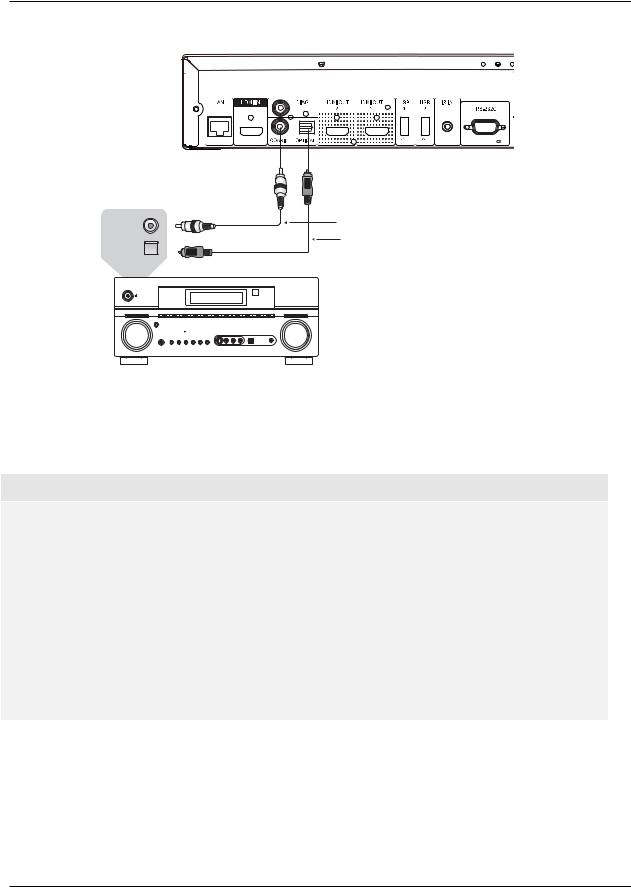
I N S T A L L A T I O N
Connecting to an A/V Receiver or Amplifier via S/PDIF (Coaxial / Optical)
Rear Panel
|
Connect one of these cables: |
Coaxial In |
Coaxial Digital Audio Cable |
Optical In |
Optical Digital Audio Cable |
|
|
|
AUDIO/VIDEO MULTI-CHANNEL RECEIVER |
Receiver/Amplifier with Dolby Digital or DTS Decoder
xPlease use either a 75-Ohm coaxial digital audio cable with RCA-style connectors or an S/PDIF optical digital audio cable to connect one of the digital audio outputs to the corresponding input terminal on your A/V receiver. For detailed setup of coaxial/optical signals, refer to page 66.
NOTE
xDue to bandwidth limitations, high resolution audio formats such as Dolby Digital Plus, Dolby TrueHD, DTS-HD High Resolution and DTS-HD Master Audio cannot be sent through the coaxial or optical digital audio output. A reduced resolution version of the same audio track will be output instead. To listen to high resolution audio formats in their best quality, please use the HDMI connection if you have a receiver that handles HDMI audio (see page 11) or use the multi-channel analog outputs if you do not (see page 16).
xDue to copyright restrictions, SACD audio cannot be sent through the coaxial or optical digital audio output. To listen to SACDs, please use the HDMI or analog audio connections.
xDue to copyright restrictions and bandwidth limitations, full resolution audio from DVD-Audio discs cannot be sent through the coaxial or optical digital audio output. To listen to DVDAudio in full resolution, please use the HDMI or analog audio connections.
17
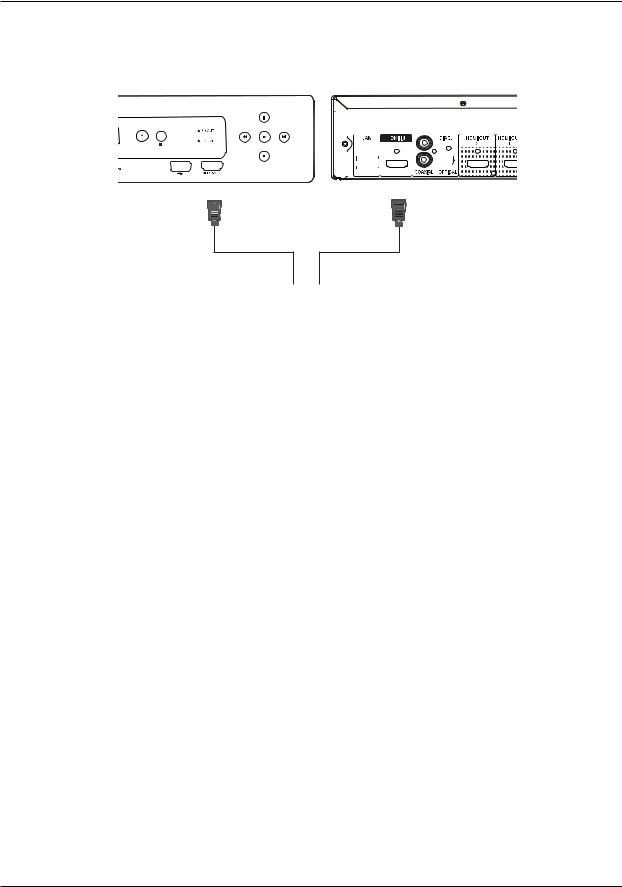
I N S T A L L A T I O N
HDMI / MHL INPUT to BDP-103
Front Panel |
|
|
|
|
|
|
|
|
|
Rear Panel |
||||||||
|
|
|
|
|
|
|
|
|
|
|
|
|
|
|
|
|
|
|
|
|
|
|
|
|
|
|
|
|
|
|
|
|
|
|
|
|
|
|
|
|
|
|
|
|
|
|
|
|
|
|
|
|
|
|
|
|
|
|
|
|
|
|
|
|
|
|
|
|
|
|
|
|
|
|
|
|
|
|
|
|
|
|
|
|
|
|
|
|
|
|
|
|
|
|
|
|
|
|
|
|
|
|
|
|
|
|
|
|
|
|
|
|
|
|
|
|
|
|
|
|
|
|
|
|
|
|
|
|
|
|
|
|
|
|
|
|
|
|
|
|
|
|
|
|
|
|
|
|
|
|
|
|
|
|
|
|
|
|
|
|
|
|
|
|
|
|
|
|
|
|
|
|
|
|
|
|
|
|
|
|
|
|
|
|
|
|
|
|
|
|
|
|
|
|
|
|
|
|
|
|
|
|
|
|
|
|
|
|
|
|
|
|
|
|
|
|
|
|
|
|
|
|
|
|
|
|
|
|
|
|
|
|
|
|
|
|
|
|
|
|
|
|
|
|
|
|
|
|
|
|
|
|
|
|
|
|
|
|
|
|
|
|
|
|
|
HDMI Cable |
HDMI Cable |
or HDMI/MHL Cable
Audio/Video Source
xThe BDP-103 provides two HDMI input ports, located on the front panel and the back panel separately, both of which can accept up to 1080p high-definition video and digital audio. You can use the included HDMI cable to connect a source device such as a digital TV box, mobile phone or camcorder to the HDMI IN port(s). You can use the INPUT button on the OPPO remote to open the Input Source Menu, which allows you to select the corresponding HDMI IN port.
xKeep in mind that the HDMI IN port on the front panel is MHL (Mobile High-definition Link) compatible, which means if it is connected to another MHL-enabled device (like a smartphone) through a MHL cable or adaptor (not included), then this port is not only capable of accepting high-resolution digital signals, but can also simultaneously charge the connected device.
18

I N S T A L L A T I O N
Connecting to the Internet
The BDP-103 has significantly improved its internet streaming capabilities compared to its predecessors. Currently, it supports both Netflix and VUDU, as well as in-home network media sharing via My Network which is capable of connecting with DLNA and SMB/CIFS clients. Additional online streaming applications may also be added with future firmware updates.
The BDP-103 also supports the BD-Live feature offered on some Blu-ray Disc titles. BD-Live offers extra downloadable content and additional online interactive programs. Content available on BD-Live varies by disc and studio, and may include additional subtitles, commentaries, movie trailers, games, and online chat.
Connecting the player to the Internet will also allow the player to obtain firmware updates. (See pages 4 and 72 for more information regarding firmware updates.)
In order to utilize the BD-Live feature or to update the firmware via the Internet, the player needs to be connected to a broadband Internet connection. It is not necessary to connect to the Internet if you do not intend to use the network streaming, BD-Live or online firmware update features.
The BDP-103 provides two network connection methods: through Ethernet cable or through the external wireless adaptor included with the player. For the fastest and most stable network connection, we recommend using an Ethernet cable whenever possible.
Internet connection through Ethernet cable
Rear Panel
Broadband Internet |
Network Cable |
||
Connection |
(Ethernet) |
||
|
|
|
|
Internet
WAN |
1 |
2 LAN 3 |
4 |
Broadband Router/Modem
xPlug one end of a network cable (Category 5/5E straight Ethernet cable) into the LAN port on the back of the BDP-103.
xPlug the other end of the network cable into a LAN port on the broadband router or modem.
xAfter physically connecting the player to a broadband Internet connection, some network configuration may be required. Refer to the Network Setup section on page 76 for details.
19
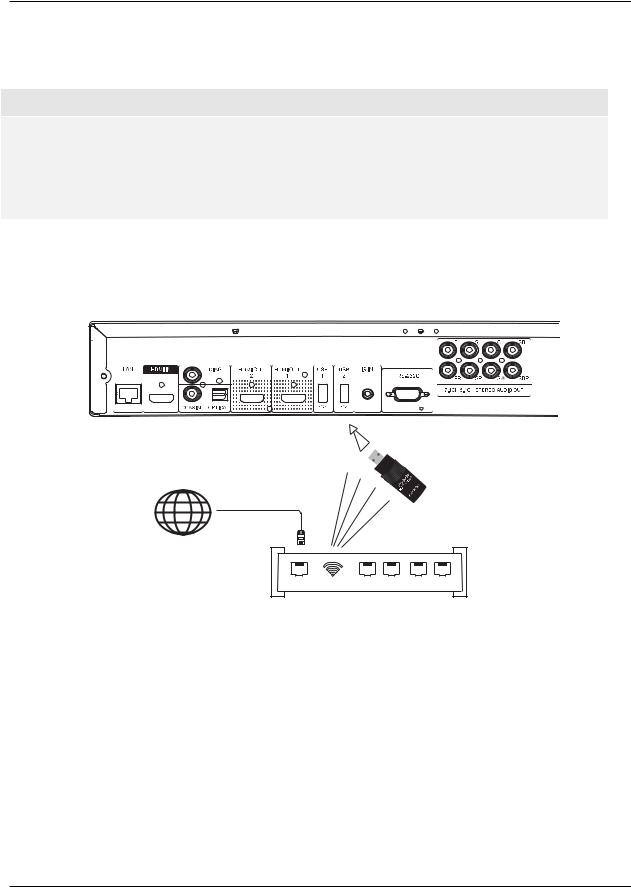
I N S T A L L A T I O N
xRefer to the operating instructions supplied with the broadband router or modem, or contact the Internet service provider for questions related to setting up the router or modem.
NOTE
xOnly connect the LAN port of the player to an Ethernet port that supports 10BASE-T or 100BASE-TX. Connecting to any other ports or jacks, such as a phone jack, can damage the player.
xStreaming services such as Netflix and VUDU may require membership and may also be limited to service in the US only.
Internet connection through wireless adaptor
Rear Panel
USB IN
Wireless Dongle
Broadband Internet
Connection
Internet
Internet WiFi |
1 |
2 LAN 3 |
4 |
Wireless Router/Access Point
xThe wireless adaptor included in the BDP-103 package has been pre-configured to work with your player. It is compatible with 802.11B, G, and N (2.4GHz) wireless networks.
xMake sure a broadband Internet connection is available and the Wi-Fi function on your wireless router or access point has been turned on, and plug the adaptor into one of the three USB ports available on your BDP-103 (one on the front panel, two on the back).
xAfter connecting the adaptor, some network configuration is required. Refer to the Network Setup section on page 76 for details.
xA USB extension cable is also included in the package. Connect it between the USB port on the player and your wireless adaptor if needed.
20
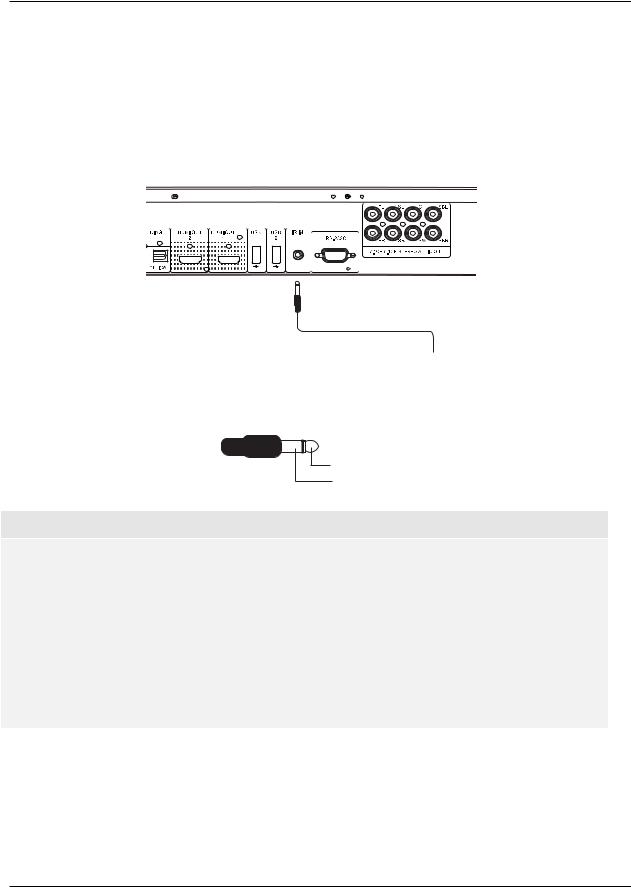
I N S T A L L A T I O N
Custom Installation
External IR (Infrared Remote) Installation
The BDP-103 features an IR IN port on its back panel. If the player is to be installed in an equipment cabinet where direct line-of-sight is not available for the remote control, you can purchase an external IR Remote Sensor and plug it into the IR IN port. Place the sensor head at a location where there is direct line-of-sight to ensure reliable operation.
Rear Panel
3.5mm Mono Cable
External IR Remote Signal
IR IN Signal Identifications
3.5mm Mono Plug
Tip: IR carrier signal
Sleeve: Ground
NOTE
xWhen an external IR sensor is plugged in, the original IR sensor window on the front panel will be disabled.
xThe IR port on the BDP-103 is NOT compatible with the prior generation of external IR Remote Sensor (IR-ES1) which is used on BDP-83.
xOPPO cannot guarantee that the IR IN port will be compatible with devices that are not manufactured by OPPO. Connecting the IR IN port to an incompatible device may result in damage to the connected device or the player.
xPlease contact OPPO customer support if you plan to integrate the player into an IR distribution system. Customer support can provide recommendations on how to properly connect the control signals.
RS232 Control
The BDP-103 has an RS232 control port and can be integrated into most custom home theater control systems. Please ask your custom installer to contact OPPO for the RS232 control protocol, or check the OPPO Digital website (www.oppodigital.com) for the latest version of RS-232 protocol document.
21

I N S T A L L A T I O N
Quick Start Guide
Power On and Play
The BDP-103 is pre-configured with settings that have been optimized for most home theater systems, so it can fit into your audio/video system without any additional adjustment. To begin, please follow these steps:
1.Connect the OPPO player into your system.
2.Turn on the TV and/or receiver/amplifier, and then turn on the player.
3.Switch the input selection on your TV or receiver so that the TV displays the signal from the player.
Within a few seconds, the player will load the factory default settings and you will see the Home Menu with an OPPO logo. The player is now ready for use. Enjoy your new OPPO Blu-ray Disc Player!
Please follow the rest of the user manual for information on basic and advanced operations.
Select the Best Output Resolution
One of the major advantages of the BDP-103 is its ability to play high-definition Blu-ray video and also upconvert standard definition video stored on DVD discs to high definition. The sophisticated video processor inside the player ensures that the video will have the best possible color, detail and motion. The player offers several standard and high definition video output resolutions. For best results, it is important to select an output resolution that best matches your TV or display.
The rule of thumb when selecting an output resolution is to match the “native resolution” of your TV or display as closely as possible. The “native resolution” is the resolution of the actual display component in the TV, such as the Plasma panel, LCD panel, or DLP™ chip. The TV may accept input signals with lower or higher resolutions than its native resolution. In such cases, the electronics in the TV will upscale or downscale the video to fit its display component. Unfortunately, many TVs on the market only do an average job of scaling the video. On the other hand, if you set the BDP-103 to output a resolution that matches or is very close to the native resolution of the TV, you are more likely to get a great picture.
For most new displays on the market, the best output resolution will be 1080p. A few early model “1080p” displays did not accept a 1080p signal. For these displays, the best output resolution is 1080i. For small screen digital TVs this will likely be 720p. For even earlier CRT tube or rear projection TVs this will likely be 1080i. For EDTV displays (very rare if they have HDMI or DVI) this will be 480p (NTSC) or 576p (PAL). These are general recommendations that work for most users, but there can be exceptions. Advanced users may want to try all supported resolutions and choose the one that provides the best result visually.
The BDP-103 supports a special Source Direct mode through its HDMI outputs. This resolution is recommended for use with external video processors or high-end TVs. In Source Direct mode, the player works as a “transport”. It decodes video from the discs and then sends the raw video signal in its native resolution and format, without extra processing, to the external video processor or TV. The actual output resolution varies by content:
Content |
Source Direct Output Resolution |
|
NTSC DVD |
480i |
|
PAL DVD |
576i |
|
Most Blu-ray Movies (film-source) |
1080p 23.976Hz or 1080p 24Hz |
|
Most Blu-ray TV shows or Concerts |
1080i |
|
(video-source) |
||
|
||
SACD and DVD-Audio |
1080p |
22

I N S T A L L A T I O N
For both HDMI outputs, the following output resolutions are available: 4Kx2K, Auto, 1080p, 1080i, 720p, 480p/576p, 480i/576i, and Source Direct. If Auto is selected, the player will determine the output resolution based on the best signal resolution that the TV can display.
To change the output resolution, press the RESOLUTION button on the remote to bring the Resolution Menu, then press the UP/DOWN ARROW buttons to highlight the desired one, and press the ENTER button to confirm and return. If your TV does not support the selected resolution, you may see a black screen or an error message. In this case, try a different resolution that your TV can support.
Determine the Display Aspect Ratio
Standard Definition, or 4:3 TV |
Wide screen, or 16:9 TV |
The TV Aspect Ratio is the proportional ratio of a TV screen’s width and height. Older television sets generally have a 4:3 aspect ratio – the width is 4/3 (or 1.33) times the height. Newer wide screen television sets have a 16:9 aspect ratio – the width is 16/9 (or 1.78) times the height. For best performance, the video output of your player needs to match the screen aspect ratio of your TV. Since most Blu-ray discs and many DVD discs are released in the wide screen format, it is highly recommended to use a wide screen TV with the BDP-103.
The Aspect Ratio selections are 16:9 Wide and 16:9 Wide/Auto. Depending on your selection and the video format recorded on the discs, image appearance on the TV screen can be one of the following:
TV Screen Appearance |
|
Original Content |
16:9 |
Wide |
Wide/Auto |
4:3 |
|
16:9 |
|
If you have a widescreen (16:9) display, select one of these options:
x16:9 Wide – 16:9 (widescreen) sources will be displayed in their native aspect ratio, and 4:3 sources will be horizontally stretched.
x16:9 Wide/Auto – 16:9 (widescreen) as well as 4:3 sources will be displayed in their native aspect ratio. Please note that in this mode, 4:3 sources will be displayed with black borders on both left and right sides to maintain the correct 4:3 aspect ratio.
23
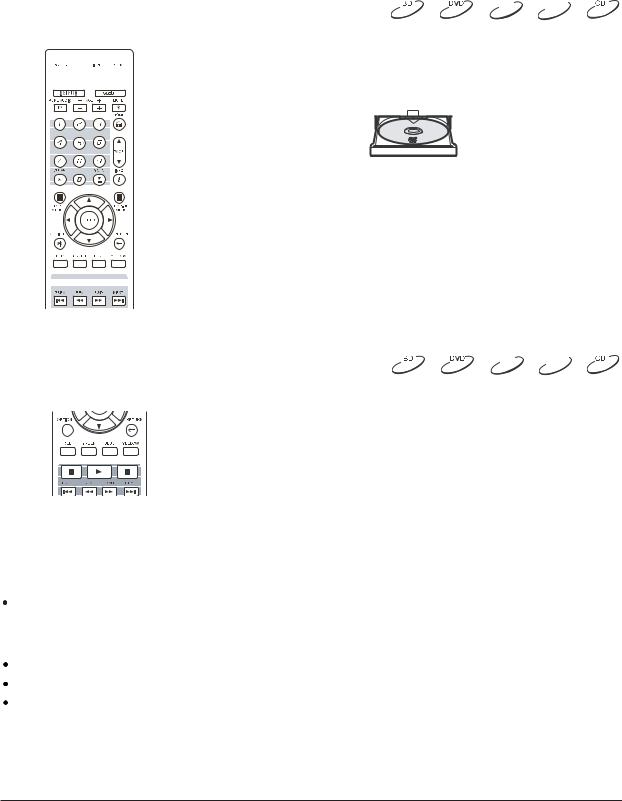
BASIC OPERATIONS
Disc Playback
POWER 


 OPEN
OPEN
STOP 


 PLAY
PLAY
DVD-A SACD
1 Press the POWER button to turn on the player.
Press the POWER button to turn on the player.
2 Press the OPEN/CLOSE button to eject the disc tray.
Press the OPEN/CLOSE button to eject the disc tray.
3 Place the disc with the label side facing up and the recorded side facing down.
Place the disc with the label side facing up and the recorded side facing down.
4 Press the OPEN/CLOSE button again to retract the tray.
Press the OPEN/CLOSE button again to retract the tray.
5 The player will read the disc information and begin playback. 6
The player will read the disc information and begin playback. 6 Depending on the content of the disc, a menu or navigation
Depending on the content of the disc, a menu or navigation
screen may appear. Use the navigation ARROW and SELECT buttons to select the content to play.
7 To stop playback, press the STOP button.
To stop playback, press the STOP button.
8 To turn off the player, press the POWER button.
To turn off the player, press the POWER button.
OPTION Menu
OPTION

DVD-A SACD
1.During media file navigation and playback, press the OPTION button on the remote to open the OPTION MENU, which allows you to conveniently access various settings and playback features.
2.When the OPTION MENU is displayed, press the LEFT/RIGHT ARROW buttons on the remote to highlight a particular item, then press the ENTER button to confirm.
The OPTION MENU selections may differ depending on content type. A summary of the selections and their functionality is described as follows:
Within Disc Playback (CD, DVD, BD):
Disc info: Searches the Gracenote online database and display the available disc information (an active internet connection is required).
Within Music File Playback:
Music info: As with “Disc info”; searches and displays available music information from Gracenote.
Shuffle/Random: Activate Shuffle or Random mode. See details on page 35.
Repeat: Repeat the track or all tracks. See details on page 34.
24
